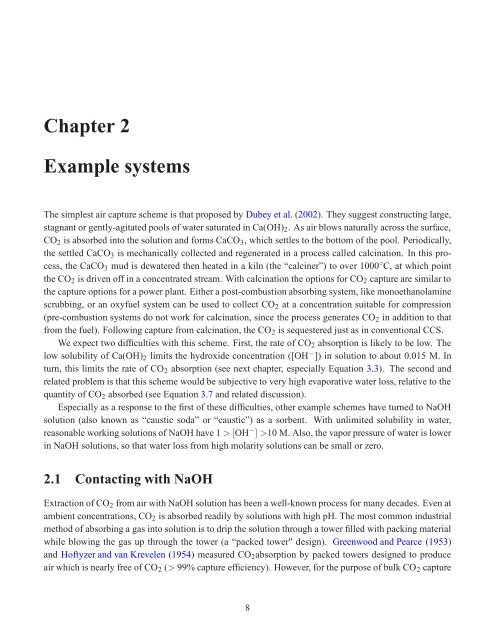Capturing CO2 from ambient air - David Keith
Capturing CO2 from ambient air - David Keith
Capturing CO2 from ambient air - David Keith
Create successful ePaper yourself
Turn your PDF publications into a flip-book with our unique Google optimized e-Paper software.
Chapter 2<br />
Example systems<br />
The simplest <strong>air</strong> capture scheme is that proposed by Dubey et al. (2002). They suggest constructing large,<br />
stagnant or gently-agitated pools of water saturated in Ca(OH)2. As <strong>air</strong> blows naturally across the surface,<br />
<strong>CO2</strong> is absorbed into the solution and forms CaCO3, which settles to the bottom of the pool. Periodically,<br />
the settled CaCO3 is mechanically collected and regenerated in a process called calcination. In this process,<br />
the CaCO3 mud is dewatered then heated in a kiln (the “calciner”) to over 1000 ◦ C, at which point<br />
the <strong>CO2</strong> is driven off in a concentrated stream. With calcination the options for <strong>CO2</strong> capture are similar to<br />
the capture options for a power plant. Either a post-combustion absorbing system, like monoethanolamine<br />
scrubbing, or an oxyfuel system can be used to collect <strong>CO2</strong> at a concentration suitable for compression<br />
(pre-combustion systems do not work for calcination, since the process generates <strong>CO2</strong> in addition to that<br />
<strong>from</strong> the fuel). Following capture <strong>from</strong> calcination, the <strong>CO2</strong> is sequestered just as in conventional CCS.<br />
We expect two difficulties with this scheme. First, the rate of <strong>CO2</strong> absorption is likely to be low. The<br />
low solubility of Ca(OH)2 limits the hydroxide concentration ([OH − ]) in solution to about 0.015 M. In<br />
turn, this limits the rate of <strong>CO2</strong> absorption (see next chapter, especially Equation 3.3). The second and<br />
related problem is that this scheme would be subjective to very high evaporative water loss, relative to the<br />
quantity of <strong>CO2</strong> absorbed (see Equation 3.7 and related discussion).<br />
Especially as a response to the first of these difficulties, other example schemes have turned to NaOH<br />
solution (also known as “caustic soda” or “caustic”) as a sorbent. With unlimited solubility in water,<br />
reasonable working solutions of NaOH have 1 > [OH − ] >10 M. Also, the vapor pressure of water is lower<br />
in NaOH solutions, so that water loss <strong>from</strong> high molarity solutions can be small or zero.<br />
2.1 Contacting with NaOH<br />
Extraction of <strong>CO2</strong> <strong>from</strong> <strong>air</strong> with NaOH solution has been a well-known process for many decades. Even at<br />
<strong>ambient</strong> concentrations, <strong>CO2</strong> is absorbed readily by solutions with high pH. The most common industrial<br />
method of absorbing a gas into solution is to drip the solution through a tower filled with packing material<br />
while blowing the gas up through the tower (a “packed tower" design). Greenwood and Pearce (1953)<br />
and Hoftyzer and van Krevelen (1954) measured <strong>CO2</strong>absorption by packed towers designed to produce<br />
<strong>air</strong> which is nearly free of <strong>CO2</strong> (> 99% capture efficiency). However, for the purpose of bulk <strong>CO2</strong> capture<br />
8








